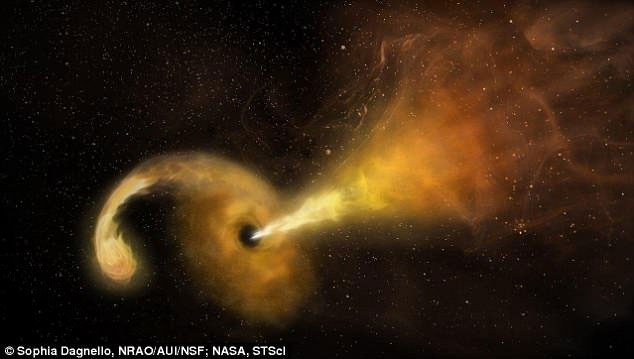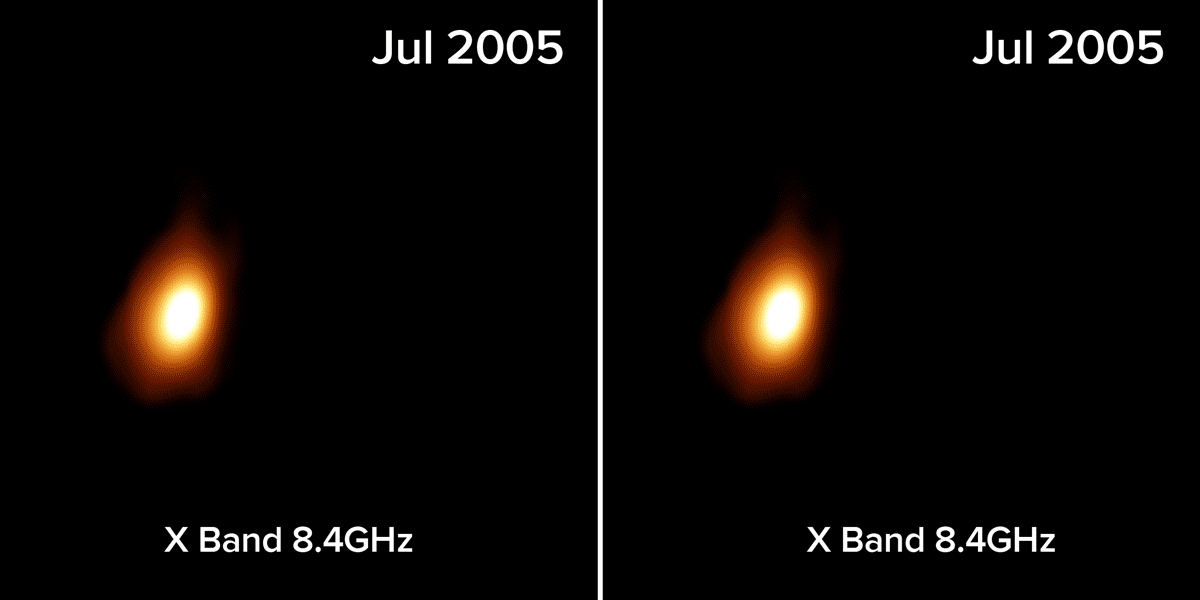Catching a super rare scene in the universe: Super giant black hole is swallowing up a star
Each galaxy center has a supermassive black hole, with millions or even billions of solar masses.
- for those who don't know yet - is a spacetime region with enormous mass, but compressed into a very narrow space. Therefore, the gravitational pull of a black hole is extremely large, not allowing anything to escape, including light. If a black hole is placed next to a star, that star will soon be swallowed up.
The "meal" black hole event (TDE - tidal disruption event) is a very frequent event, but it is extremely rare for the people we observe. But recently, experts at the University of Virginia have encountered that super-rare sight, namely that a giant black hole is swallowing up a star, located 150 million light-years away.

The giant black hole is swallowing up a star, located 150 million light-years away.
Specifically, the expert group used radio waves and infrared periscope lenses, observing a galaxy intersecting the Arp 299 . Here, a giant black hole is "tearing down" the star that is twice as massive as the Sun, creating a truly dangerous scene.
Experts say that the amount of matter absorbed from this star forms a vortex around the black hole, emitting X-rays and matter streams at the speed of light. And in particular, this black hole has 20 million times the mass of our Sun.
"We have never observed the process of forming these material flows before," said Miguel Perez-Torres, an expert from Andalusia Institute of Astrophysics in Granada (Spain).
In fact, the existence of this black hole was confirmed at the end of January 2005, with the support of William Herschel periscope in Canary Island. At that time, the group had noticed an infrared beam emitted in the nucleus of Arp 299. By mid-July, there was a source of radio waves, also from that location.

Infrared beam emitted at the nucleus of Arp 299.
Continuing to observe, the source of this radio wave started radiating in one direction. That is the first evidence of the existence of a physical stream .
The speed of this line is estimated to be only 1/4 of the speed of light, but fortunately it is not absorbed by the Arp 299 core. And now, after years of collecting data, they have confirmed and observed this scene.
"Usually black holes are in a static state, not" eating anything ".
"This newly discovered TDE phenomenon can give us the opportunity to learn more about the process of forming matter streams. In fact, these lines often appear when the supernova takes place."
The study is published in the journal Science.
Each galaxy will have a black supernova at the center, with a mass of millions or even billions of times that of the Sun. When it draws matter from a star, the mass of matter will form a disk around the black hole, along with super-fast particles coming back out.- Science warns super giant black holes that can
- Snatching up the image of a choking cosmic black hole when swallowing a star
- Satisfying the red star scene label N6946-BH1 entered the monster black hole
- The first time a black hole was discovered, it swallowed a star
- Simulating the process of cosmic black holes
- The star flies more than 1,000 km / sec after 'hiding' from the black hole
- The black hole tore apart the star
- The painful death of a star ripped apart by a supermassive black hole
- Face hiding 'monster' black hole
- Discovering 'super black holes' is 12 times bigger than the Sun.
- Incidentally the star forms near a black hole
- How is the largest 'monster' born in the universe?
 Van Allen's belt and evidence that the Apollo 11 mission to the Moon was myth
Van Allen's belt and evidence that the Apollo 11 mission to the Moon was myth The levels of civilization in the universe (Kardashev scale)
The levels of civilization in the universe (Kardashev scale) Today Mars, the sun and the Earth are aligned
Today Mars, the sun and the Earth are aligned The Amazon owner announced a secret plan to build a space base for thousands of people
The Amazon owner announced a secret plan to build a space base for thousands of people Finding the mysterious 'monster' that is making the universe expand
Finding the mysterious 'monster' that is making the universe expand  Why do images of black holes appear to be burning from the outside?
Why do images of black holes appear to be burning from the outside?  Image discovered recording a black hole jet colliding with a mysterious object
Image discovered recording a black hole jet colliding with a mysterious object  Digging the ground to discover the most expensive treasure on the planet: A country 'hit it rich' because it owns 90% of the world's reserves
Digging the ground to discover the most expensive treasure on the planet: A country 'hit it rich' because it owns 90% of the world's reserves  Earth is punctured by capturing 'primordial black hole'?
Earth is punctured by capturing 'primordial black hole'?  The flower looks like a devil's jailor, just looking at it is scary.
The flower looks like a devil's jailor, just looking at it is scary. 